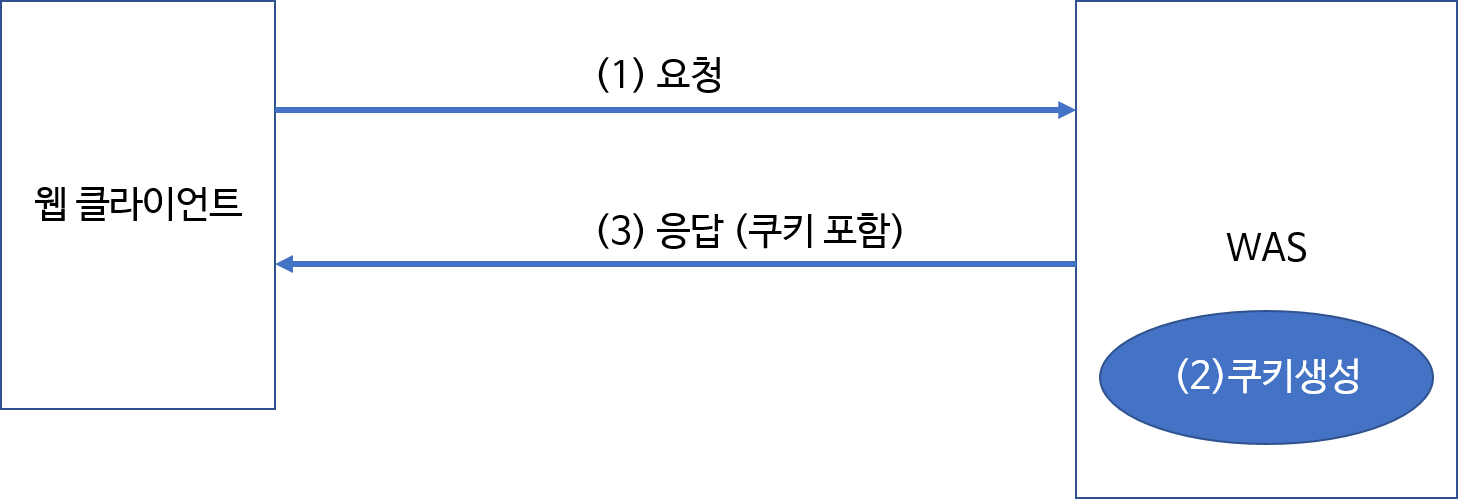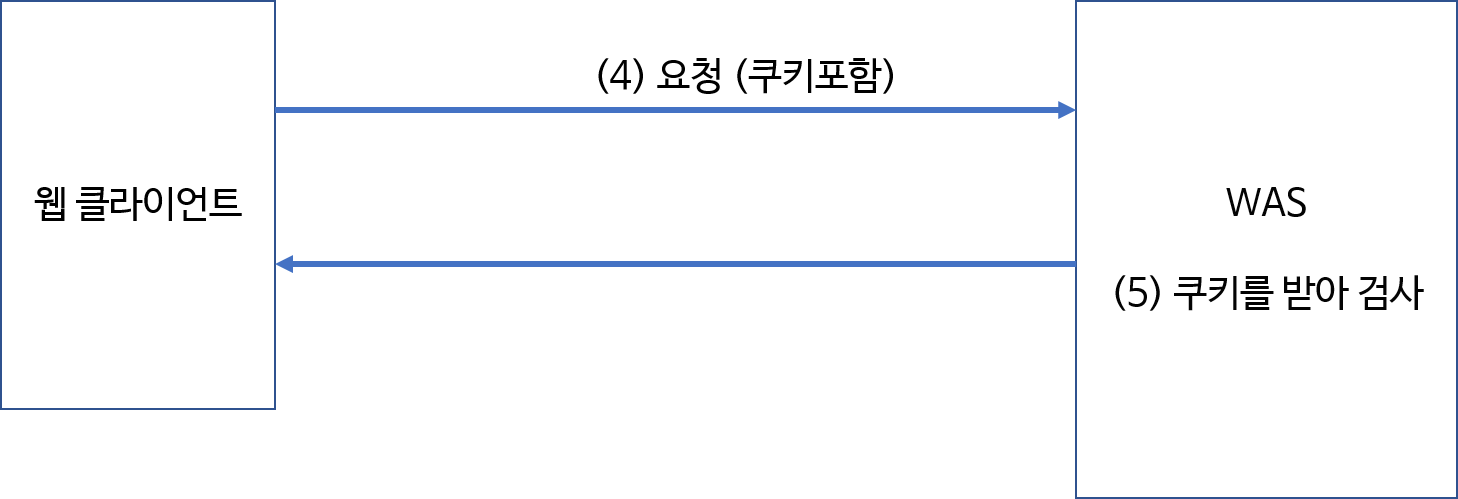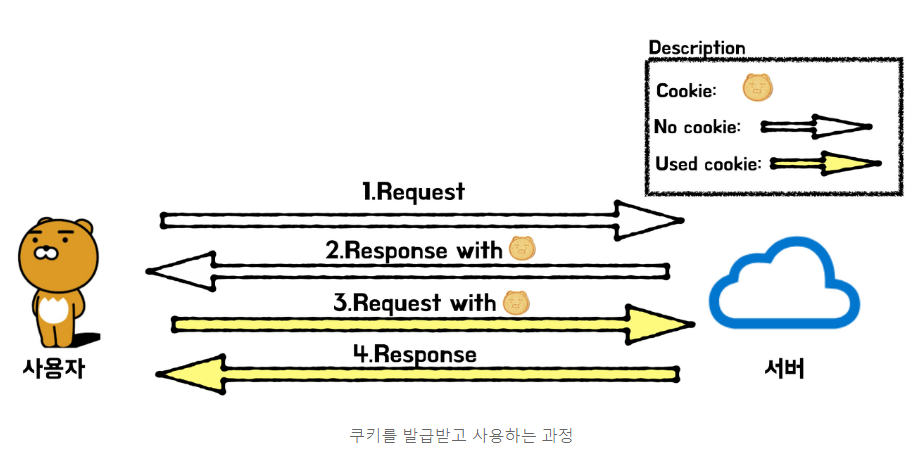
네이버 부스트코스 출처 자료
4. 상태유지기술(Cookie & Session) - BE
1) 상태정보란?
웹에서의 상태 유지 기술
HTTP프로토콜은 상태 유지가 안되는 프로토콜입니다.
- 이전에 무엇을 했고, 지금 무엇을 했는지에 대한 정보를 갖고 있지 않습니다.
- 웹 브라우저(클라이언트)의 요청에 대한 응답을 하고 나면 해당 클라이언트와의 연결을 지속하지 않습니다.
상태 유지를 위해 Cookie와 Session기술이 등장합니다.
상태유지가 안되는 프로토콜은 무상태 프로토콜(stateless protocol)이라 하고 HTTP, UDP, DNS가 있습니다.
상태를 유지하는 프로토콜은 상태 프로토콜(stateful protocol)이라 하고 FTP, Telnet이 있습니다.
쿠키(Cookie)와 세션(Session)
- 쿠키
- 사용자 컴퓨터에 저장
- 저장된 정보를 다른 사람 또는 시스템이 볼 수 있는 단점
- 유효시간이 지나면 사라짐
- 세션
- 서버에 저장
- 서버가 종료되거나 유효시간이 지나면 사라집니다.
쿠키(Cookie) 동작 이해


세션 동작 이해


2) 쿠키란?
쿠키 정의
- 클라이언트 단에 저장되는 작은 정보의 단위입니다.
- 클라이언트에서 생성하고 저장될 수 있고, 서버 단에서 전송한 쿠키가 클라이언트에 저장될 수 있습니다.
이용 방법
- 서버에서 클라이언트의 브라우저로 전송되어 사용자의 컴퓨터에 저장합니다.
- 저장된 쿠키는 다시 해당하는 웹 페이지에 접속할 때, 브라우저에서 서버로 쿠키를 전송합니다.
- 쿠키는 이름(name)과 값(value) 쌍으로 정보를 저장합니다.
- 이름-값 쌍 외에도 도메인(Domain), 경로(Path), 유효기간(Max-Age, Expires), 보안(Secure), HttpOnly 속성을 저장할 수 있습니다.
쿠키는 그 수와 크기에 제한
- 브라우저별로 제한 값을 다르게 가져가고 있습니다.
- 참고 : http://browsercookielimits.squawky.net/-
javax.servlet.http.Cookie
서버에서 쿠키 생성, Reponse의 addCookie메소드를 이용해 클라이언트에게 전송
Cookie cookie = new Cookie(이름, 값);
response.addCookie(cookie);- 쿠키는 (이름, 값)의 쌍 정보를 입력하여 생성합니다.
- 쿠키의 이름은 일반적으로 알파벳과 숫자, 언더바로 구성합니다. 정확한 정의를 알고 싶다면 RFC 6265(https://tools.ietf.org/html/rfc6265) 문서 [4.1.1 Syntax] 항목을 참조하세요.
클라이언트가 보낸 쿠키 정보 읽기
Cookie[] cookies = request.getCookies();- 쿠키 값이 없으면 null이 반환됩니다.
- Cookie가 가지고 있는 getName()과 getValue()메소드를 이용해서 원하는 쿠키정보를 찾아 사용합니다.
클라이언트에게 쿠키 삭제 요청
- 쿠키를 삭제하는 명령은 없고, maxAge가 0인 같은 이름의 쿠키를 전송합니다.
Cookie cookie = new Cookie("이름", null);
cookie.setMaxAge(0);
response.addCookie(cookie);같은 이름을 가진 두 쿠키가 존재할 수 없기 때문에 이렇게 보내면 삭제 된다.
쿠키의 유효기간 설정
- 메소드 setMaxAge()
- 인자는 유효기간을 나타내는 초 단위의 정수형
- 만일 유효기간을 0으로 지정하면 쿠키의 삭제
- 음수를 지정하면 브라우저가 종료될 때 쿠키가 삭제
- 유효기간을 10분으로 지정하려면
- cookie.setMaxAge(10 60); //초 단위 : 10분
- 1주일로 지정하려면 (7246060)로 설정합니다.

Spring MVC에서의 Cookie 사용
-
@CookieValue 애노테이션 사용
- 컨트롤러 메소드의 파라미터에서 CookieValue애노테이션을 사용함으로써 원하는 쿠키정보를 파라미터 변수에 담아 사용할 수 습니다.
-
컨트롤러메소드(@CookieValue(value="쿠키이름", required=false, defaultValue="기본값") String 변수명)
3) 쿠키를 이용한 상태정보 유지하기-1
package kr.or.connect.guestbook.controller;
import java.util.ArrayList;
import java.util.List;
import javax.servlet.http.Cookie;
import javax.servlet.http.HttpServletRequest;
import javax.servlet.http.HttpServletResponse;
import org.springframework.beans.factory.annotation.Autowired;
import org.springframework.stereotype.Controller;
import org.springframework.ui.ModelMap;
import org.springframework.web.bind.annotation.CookieValue;
import org.springframework.web.bind.annotation.GetMapping;
import org.springframework.web.bind.annotation.ModelAttribute;
import org.springframework.web.bind.annotation.PostMapping;
import org.springframework.web.bind.annotation.RequestParam;
import kr.or.connect.guestbook.dto.Guestbook;
import kr.or.connect.guestbook.service.GuestbookService;
@Controller
public class GuestbookController {
@Autowired
GuestbookService guestbookService;
@GetMapping(path="/list")
public String list(@RequestParam(name="start", required=false, defaultValue="0") int start,
ModelMap model,
HttpServletRequest request,
HttpServletResponse response) {
String value = null;
boolean find = false;
Cookie[] cookies = request.getCookies();
if(cookies != null) {
for(Cookie cookie : cookies) {
if("count".equals(cookie.getName())) {
find = true;
value = cookie.getValue();
}
}
}
if(!find) {
value = "1";
}else { // 쿠키를 찾았다면.
try {
int i = Integer.parseInt(value);
value = Integer.toString(++i);
}catch(Exception ex) {
value = "1";
}
}
Cookie cookie = new Cookie("count", value);
cookie.setMaxAge(60 * 60 * 24 * 365); // 1년 동안 유지.
cookie.setPath("/"); // / 경로 이하에 모두 쿠키 적용.
response.addCookie(cookie);
List<Guestbook> list = guestbookService.getGuestbooks(start);
int count = guestbookService.getCount();
int pageCount = count / GuestbookService.LIMIT;
if(count % GuestbookService.LIMIT > 0)
pageCount++;
List<Integer> pageStartList = new ArrayList<>();
for(int i = 0; i < pageCount; i++) {
pageStartList.add(i * GuestbookService.LIMIT);
}
model.addAttribute("list", list);
model.addAttribute("count", count);
model.addAttribute("pageStartList", pageStartList);
model.addAttribute("cookieCount", value); // jsp에게 전달하기 위해서 쿠키 값을 model에 담아 전송한다.
return "list";
}
@PostMapping(path="/write")
public String write(@ModelAttribute Guestbook guestbook,
HttpServletRequest request) {
String clientIp = request.getRemoteAddr();
System.out.println("clientIp : " + clientIp);
guestbookService.addGuestbook(guestbook, clientIp);
return "redirect:list";
}list.jsp 에서 방명록 전체 수 옆에 방문한 수를 출력하는 el 코드를 추가합니다.
- 방명록 전체 수 : ${count }
- 방문한 수 : ${cookieCount }<br><br>
3) 쿠키를 이용한 상태정보 유지하기-2
package kr.or.connect.guestbook.controller;
import java.util.ArrayList;
import java.util.List;
import javax.servlet.http.Cookie;
import javax.servlet.http.HttpServletRequest;
import javax.servlet.http.HttpServletResponse;
import org.springframework.beans.factory.annotation.Autowired;
import org.springframework.stereotype.Controller;
import org.springframework.ui.ModelMap;
import org.springframework.web.bind.annotation.CookieValue;
import org.springframework.web.bind.annotation.GetMapping;
import org.springframework.web.bind.annotation.ModelAttribute;
import org.springframework.web.bind.annotation.PostMapping;
import org.springframework.web.bind.annotation.RequestParam;
import kr.or.connect.guestbook.dto.Guestbook;
import kr.or.connect.guestbook.service.GuestbookService;
@Controller
public class GuestbookController {
@Autowired
GuestbookService guestbookService;
@GetMapping(path="/list")
public String list(@RequestParam(name="start", required=false, defaultValue="0") int start,
ModelMap model, @CookieValue(value="count", defaultValue="1", required=true) String value,
HttpServletResponse response) {
// 쿠키 값을 1증가 시킨다.
try {
int i = Integer.parseInt(value);
value = Integer.toString(++i);
}catch(Exception ex){
value = "1";
}
// 쿠키를 전송한다.
Cookie cookie = new Cookie("count", value);
cookie.setMaxAge(60 * 60 * 24 * 365); // 1년 동안 유지.
cookie.setPath("/"); // / 경로 이하에 모두 쿠키 적용.
response.addCookie(cookie);
List<Guestbook> list = guestbookService.getGuestbooks(start);
int count = guestbookService.getCount();
int pageCount = count / GuestbookService.LIMIT;
if(count % GuestbookService.LIMIT > 0)
pageCount++;
List<Integer> pageStartList = new ArrayList<>();
for(int i = 0; i < pageCount; i++) {
pageStartList.add(i * GuestbookService.LIMIT);
}
model.addAttribute("list", list);
model.addAttribute("count", count);
model.addAttribute("pageStartList", pageStartList);
model.addAttribute("cookieCount", value); // 쿠키를 추가한다.
return "list";
}
@PostMapping(path="/write")
public String write(@ModelAttribute Guestbook guestbook,
HttpServletRequest request) {
String clientIp = request.getRemoteAddr();
System.out.println("clientIp : " + clientIp);
guestbookService.addGuestbook(guestbook, clientIp);
return "redirect:list";
}
}4) Session이란?
세션
정의
- 클라이언트 별로 서버에 저장되는 정보
이용 방법
- 웹 클라이언트가 서버측에 요청을 보내게 되면 서버는 클라이언트를 식별하는 session id를 생성합니다.
- 서버는 session id를 이용해서 key와 value를 이용한 저장소인 HttpSession을 생성합니다.
- 서버는 session id를 저장하고 있는 쿠키를 생성하여 클라이언트에 전송합니다.
- 클라이언트는 서버측에 요청을 보낼때 session id를 가지고 있는 쿠키를 전송합니다.
- 서버는 쿠키에 있는 session id를 이용해서 그 전 요청에서 생성한 HttpSession을 찾고 사용합니다.
세션 생성 및 얻기
HttpSession session = request.getSession();
HttpSession session = request.getSession(true);- request의 getSession()메소드는 서버에 생성된 세션이 있다면 세션을 반환하고 없다면 새롭게 세션을 생성하여 반환합니다.
- 새롭게 생성된 세션인지는 HttpSession이 가지고 있는 isNew()메소드를 통해 알 수 있습니다.
HttpSession session = request.getSession(false);- request의 getSession()메소드에 파라미터로 false를 전달하면, 이미 생성된 세션이 있다면 반환하고 없으면 null을 반환합니다.
세션에 값 저장
setAttribute(String name, Object value)- name과 value의 쌍으로 객체 Object를 저장하는 메소드입니다.
- 세션이 유지되는 동안 저장할 자료를 저장합니다.
session.setAttribute(이름, 값)세션에 값 조회
getAttribute(String name) 메소드
- 세션에 저장된 자료는 다시 getAttribute(String name) 메소드를 이용해 조회합니다.
- 반환 값은 Object 유형이므로 저장된 객체로 자료유형 변환이 필요합니다.
- 메소드 setAttribute()에 이용한 name인 “id”를 알고 있다면 바로 다음과 같이 바로 조회합니다.
String value = (String) session.getAttribute("id");세션에 값 삭제
- removeAttribute(String name) 메소드
- name값에 해당하는 세션 정보를 삭제합니다.
- invalidate() 메소드
- 모든 세션 정보를 삭제합니다.
javax.servlet.http.HttpSession


세션은 클라이언트가 서버에 접속하는 순간 생성
- 특별히 지정하지 않으면 세션의 유지 시간은 기본 값으로 30분 설정합니다.
- 세션의 유지 시간이란 서버에 접속한 후 서버에 요청을 하지 않는 최대 시간입니다.
- 30분 이상 서버에 전혀 반응을 보이지 않으면 세션이 자동으로 끊어집니다.
- 이 세션 유지 시간은 web.xml파일에서 설정 가능합니다.
<session-config>
<session-timeout>30</session-timeout>
</session-config>5) Session을 이용한 상태정보 유지하기
실습코드
- /guess로 요청을 하면 컴퓨터가 1부터 100 사이의 임의의 값 중의 하나를 맞춰보라는 메시지가 출력합니다.
- 해당 값은 세션에 저장합니다.
- 사용자는 1부터 100 사이의 값을 입력합니다.
- 입력한 값이 세션 값보다 작으면, 입력한 값이 작다고 출력합니다.
- 입력한 값이 세션 값보다 크면, 입력한 값이 크다고 출력합니다.
- 입력한 값이 세션 값과 같다면 몇 번째에 맞췄다고 출력합니다.
GuessNumberController
package kr.or.connect.guestbook.controller;
import javax.servlet.http.HttpSession;
import org.springframework.stereotype.Controller;
import org.springframework.ui.ModelMap;
import org.springframework.web.bind.annotation.GetMapping;
import org.springframework.web.bind.annotation.RequestParam;
@Controller
public class GuessNumberController {
@GetMapping("/guess")
public String guess(@RequestParam(name="number", required=false) Integer number,
HttpSession session,
ModelMap model) {
String message = null;
// get방식으로 /guess 를 요청하는데 파라미터 number가 없을 경우에는 session에 count를 0으로 randomNumber엔 1부터 100사이의 값을 저장합니다.
if(number == null) {
session.setAttribute("count", 0);
session.setAttribute("randomNumber", (int)(Math.random() * 100) + 1); // 1 ~ 100사이의 random값
message = "내가 생각한 숫자를 맞춰보세요.";
}else {
// number파라미터가 있을 경우 세션에서 값을 읽어들인 후, number와 세션에 저장된 값을 비교합니다.
// 값을 비교해서 작거나 크다면 카운트를 1증가시켜주고
// 값이 같다면 세션 정보를 삭제합니다.
// 각 상황에 맞는 메시지를 message변수에 저장을 한 후 jsp에게 전달하기 위해서 ModelMap의 addAttribute메소드를 통해 전달하게 됩니다.
int count = (Integer)session.getAttribute("count");
int randomNumber = (Integer)session.getAttribute("randomNumber");
if(number < randomNumber) {
message = "입력한 값은 내가 생각하고 있는 숫자보다 작습니다.";
session.setAttribute("count", ++count);
}else if(number > randomNumber) {
message = "입력한 값은 내가 생각하고 있는 숫자보다 큽니다.";
session.setAttribute("count", ++count);
}else {
message = "OK " + ++count + " 번째 맞췄습니다. 내가 생각한 숫자는 " + number + " 입니다.";
session.removeAttribute("count");
session.removeAttribute("randomNumber");
}
}
model.addAttribute("message", message);
return "guess";
}
}guess.jsp
<%@ page language="java" contentType="text/html; charset=UTF-8"
pageEncoding="UTF-8"%>
<%@ taglib prefix="c" uri="http://java.sun.com/jsp/jstl/core" %>
<!DOCTYPE html PUBLIC "-//W3C//DTD HTML 4.01 Transitional//EN" "http://www.w3.org/TR/html4/loose.dtd">
<html>
<head>
<meta http-equiv="Content-Type" content="text/html; charset=UTF-8">
<title>숫자 맞추기 게임</title>
</head>
<body>
<h1> 숫자 맞추기 게임.</h1>
<hr>
<h3>${message }</h3>
<c:if test="${sessionScope.count != null}">
<form method="get" action="guess">
1부터 100사이의 숫자로 맞춰주세요.<br>
<input type="text" name="number"><br>
<input type="submit" value="확인">
</form>
</c:if>
<a href="guess">게임 다시 시작하기.</a>
</body>
</html>5. Spring 에서의 Session 사용법 - BE
1) Spring MVC에서 Session사용하기
@SessionAttributes & @ModelAttribute
@SessionAttributes 파라미터로 지정된 이름과 같은 이름이 @ModelAttribute에 지정되어 있을 경우 메소드가 반환되는 값은 세션에 저장됩니다.
아래의 예제는 세션에 값을 초기화하는 목적으로 사용되었습니다.
@SessionAttributes("user")
public class LoginController {
@ModelAttribute("user")
public User setUpUserForm() {
return new User();
}
}@SessionAttributes의 파라미터와 같은 이름이 @ModelAttribute에 있을 경우 세션에 있는 객체를 가져온 후, 클라이언트로 전송받은 값을 설정합니다.
@Controller
@SessionAttributes("user")
public class LoginController {
......
@PostMapping("/dologin")
public String doLogin(@ModelAttribute("user") User user, Model model) {
......
}
}@SessionAttribute
메소드에 @SessionAttribute가 있을 경우 파라미터로 지정된 이름으로 등록된 세션 정보를 읽어와서 변수에 할당합니다.
@GetMapping("/info")
public String userInfo(@SessionAttribute("user") User user) {
//...
//...
return "user";
}SessionStatus
SessionStatus 는 컨트롤러 메소드의 파라미터로 사용할 수 있는 스프링 내장 타입입니다.
이 오브젝트를 이용하면 현재 컨트롤러의 @SessionAttributes에 의해 저장된 오브젝트를 제거할 수 있습니다.
@Controller
@SessionAttributes("user")
public class UserController {
......
@RequestMapping(value = "/user/add", method = RequestMethod.POST)
public String submit(@ModelAttribute("user") User user, SessionStatus sessionStatus) {
......
sessionStatus.setComplete();
......
}
}Spring MVC - form tag 라이브러리
modelAttribute속성으로 지정된 이름의 객체를 세션에서 읽어와서 form태그로 설정된 태그에 값을 설정합니다.
<form:form action="login" method="post" modelAttribute="user">
Email : <form:input path="email" /><br>
Password : <form:password path="password" /><br>
<button type="submit">Login</button>
</form:form>실습코드
- 관리자는 /loginform에서 암호를 입력해 로그인을 한다.
- 관리자가 암호를 맞게 입력할 경우 세션에 로그인 정보가 저장된다.
- 세션에 로그인 정보가 있을 경우 방명록에는 "삭제" 링크가 보여진다.
- 삭제 링크를 누르면 삭제가 된다. 삭제 작업에서도 로그인 정보가 있는지를 검사해야 한다.
GuestbookAdminController.java
package kr.or.connect.guestbook.controller;
import javax.servlet.http.HttpSession;
import org.springframework.stereotype.Controller;
import org.springframework.web.bind.annotation.GetMapping;
import org.springframework.web.bind.annotation.PostMapping;
import org.springframework.web.bind.annotation.RequestParam;
import org.springframework.web.bind.support.SessionStatus;
import org.springframework.web.servlet.mvc.support.RedirectAttributes;
@Controller
public class GuestbookAdminController {
@GetMapping(path="/loginform")
public String loginform() {
return "loginform";
}
@PostMapping(path="/login")
public String login(@RequestParam(name="passwd", required=true) String passwd,
HttpSession session,
RedirectAttributes redirectAttr) {
if("1234".equals(passwd)) {
session.setAttribute("isAdmin", "true");
}else {
redirectAttr.addFlashAttribute("errorMessage","암호가 틀렸습니다.");
return "redirect:/loginform";
}
return "redirect:/list";
}
@GetMapping(path="/logout")
public String login(HttpSession session) {
session.removeAttribute("isAdmin");
return "redirect:/list";
}
}loginform.jsp
<%@ page language="java" contentType="text/html; charset=UTF-8"
pageEncoding="UTF-8"%>
<!DOCTYPE html PUBLIC "-//W3C//DTD HTML 4.01 Transitional//EN" "http://www.w3.org/TR/html4/loose.dtd">
<html>
<head>
<meta http-equiv="Content-Type" content="text/html; charset=UTF-8">
<title>loginform</title>
</head>
<body>
<h1>관리자 로그인</h1>
<br><br>
${errorMessage}<br>
<form method="post" action="login">
암호 : <input type="password" name="passwd"><br>
<input type="submit">
</form>
</body>
</html>기존 코드에서 /delete 삭제 부분을 추가합니다.
세션에 isAdmin이름의 값이 있을 경우에만 삭제 처리를 하도록 합니다.
GuestbookController.java
package kr.or.connect.guestbook.controller;
import java.util.ArrayList;
import java.util.List;
import javax.servlet.http.Cookie;
import javax.servlet.http.HttpServletRequest;
import javax.servlet.http.HttpServletResponse;
import org.springframework.beans.factory.annotation.Autowired;
import org.springframework.stereotype.Controller;
import org.springframework.ui.ModelMap;
import org.springframework.web.bind.annotation.CookieValue;
import org.springframework.web.bind.annotation.GetMapping;
import org.springframework.web.bind.annotation.ModelAttribute;
import org.springframework.web.bind.annotation.PostMapping;
import org.springframework.web.bind.annotation.RequestParam;
import org.springframework.web.bind.annotation.SessionAttribute;
import org.springframework.web.servlet.mvc.support.RedirectAttributes;
import kr.or.connect.guestbook.dto.Guestbook;
import kr.or.connect.guestbook.service.GuestbookService;
@Controller
public class GuestbookController {
@Autowired
GuestbookService guestbookService;
@GetMapping(path="/list")
public String list(@RequestParam(name="start", required=false, defaultValue="0") int start,
ModelMap model, @CookieValue(value="count", defaultValue="1", required=true) String value,
HttpServletResponse response) {
try {
int i = Integer.parseInt(value);
value = Integer.toString(++i);
}catch(Exception ex){
value = "1";
}
Cookie cookie = new Cookie("count", value);
cookie.setMaxAge(60 * 60 * 24 * 365); // 1년 동안 유지.
cookie.setPath("/"); // / 경로 이하에 모두 쿠키 적용.
response.addCookie(cookie);
List<Guestbook> list = guestbookService.getGuestbooks(start);
int count = guestbookService.getCount();
int pageCount = count / GuestbookService.LIMIT;
if(count % GuestbookService.LIMIT > 0)
pageCount++;
List<Integer> pageStartList = new ArrayList<>();
for(int i = 0; i < pageCount; i++) {
pageStartList.add(i * GuestbookService.LIMIT);
}
model.addAttribute("list", list);
model.addAttribute("count", count);
model.addAttribute("pageStartList", pageStartList);
model.addAttribute("cookieCount", value);
return "list";
}
@PostMapping(path="/write")
public String write(@ModelAttribute Guestbook guestbook,
HttpServletRequest request) {
String clientIp = request.getRemoteAddr();
System.out.println("clientIp : " + clientIp);
guestbookService.addGuestbook(guestbook, clientIp);
return "redirect:list";
}
@GetMapping(path="/delete")
public String delete(@RequestParam(name="id", required=true) Long id,
@SessionAttribute("isAdmin") String isAdmin,
HttpServletRequest request,
RedirectAttributes redirectAttr) {
if(isAdmin == null || !"true".equals(isAdmin)) { // 세션값이 true가 아닐 경우
redirectAttr.addFlashAttribute("errorMessage", "로그인을 하지 않았습니다.");
return "redirect:loginform";
}
String clientIp = request.getRemoteAddr();
guestbookService.deleteGuestbook(id, clientIp);
return "redirect:list";
}
}기존 list.jsp에서 isAdmin세션값이 있을 경우 삭제 링크를 걸업줍니다.
<%@ page language="java" contentType="text/html; charset=UTF-8"
pageEncoding="UTF-8"%>
<%@ taglib prefix="c" uri="http://java.sun.com/jsp/jstl/core" %>
<!DOCTYPE html PUBLIC "-//W3C//DTD HTML 4.01 Transitional//EN" "http://www.w3.org/TR/html4/loose.dtd">
<html>
<head>
<meta http-equiv="Content-Type" content="text/html; charset=UTF-8">
<title>방명록 목록</title>
</head>
<body>
<h1>방명록</h1>
<br>
방명록 전체 수 : ${count }, 방문한 수 : ${cookieCount }<br><br>
<c:forEach items="${list}" var="guestbook">
${guestbook.id }<br>
${guestbook.name }<br>
${guestbook.content }<br>
${guestbook.regdate }<br>
<c:if test="${sessionScope.isAdmin == 'true'}"><a href="delete?id=${guestbook.id}">삭제</a><br><br></c:if>
</c:forEach>
<br>
<c:forEach items="${pageStartList}" var="pageIndex" varStatus="status">
<a href="list?start=${pageIndex}">${status.index +1 }</a>
</c:forEach>
<br><br>
<form method="post" action="write">
name : <input type="text" name="name"><br>
<textarea name="content" cols="60" rows="6"></textarea><br>
<input type="submit" value="등록">
</form>
</body>
</html>인프런 강의 출처 자료
블로그 출처 자료

HTTP의 특징과 쿠키와 세션을 사용하는 이유
-
HTTP 프로토콜의 특징이자 약점을 보완하기 위해서 사용한다.
-
HTTP 프로토콜 환경에서 서버는 클라이언트가 누구인지 확인해야합니다. 그 이유는 HTTP 프로토콜이 connectionless, stateless한 특성이 있기 때문입니다.
connectionless
클라이언트가 요청을 한 후 응답을 받으면 그 연결을 끊어 버리는 특징
HTTP는 먼저 클라이언트가 request를 서버에 보내면, 서버는 클라이언트에게 요청에 맞는 response를 보내고 접속을 끊는 특성이 있다.
헤더에 keep-alive라는 값을 줘서 커넥션을 재활용하는데 HTTP1.1에서는 이것이 디폴트다.
HTTP가 tcp위에서 구현되었기 때문에 (tcp는 연결지향,udp는 비연결지향) 네트워크 관점에서 keep-alive는 옵션으로 connectionless의 연결비용을 줄이는 것을 장점으로 비연결지향이라 한다.
stateless
stateless
통신이 끝나면 상태를 유지하지 않는 특징
연결을 끊는 순간 클라이언트와 서버의 통신이 끝나며 상태 정보는 유지하지 않는 특성이 있다.
쿠키와 세션은 위의 두 가지 특징을 해결하기 위해 사용합니다.
예를 들어, 쿠키와 세션을 사용하지 않으면 쇼핑몰에서 옷을 구매하려고 로그인을 했음에도, 페이지를 이동할 때 마다 계속 로그인을 해야 합니다.
쿠키와 세션을 사용했을 경우, 한 번 로그인을 하면 어떠한 방식에 의해서 그 사용자에 대한 인증을 유지하게 됩니다.
쿠키
쿠키란?
-
쿠키는 클라이언트(브라우저) 로컬에 저장되는 키와 값이 들어있는 작은 데이터 파일입니다.
-
사용자 인증이 유효한 시간을 명시할 수 있으며, 유효 시간이 정해지면 브라우저가 종료되어도 인증이 유지된다는 특징이 있습니다.
-
쿠키는 클라이언트의 상태 정보를 로컬에 저장했다가 참조합니다.
-
클라이언트에 300개까지 쿠키저장 가능, 하나의 도메인당 20개의 값만 가질 수 있음, 하나의 쿠키값은 4KB까지 저장합니다.
-
Response Header에 Set-Cookie 속성을 사용하면 클라이언트에 쿠키를 만들 수 있습니다.
-
쿠키는 사용자가 따로 요청하지 않아도 브라우저가 Request시에 Request Header를 넣어서 자동으로 서버에 전송합니다.
쿠키의 구성 요소
-
이름 : 각각의 쿠키를 구별하는 데 사용되는 이름
-
값 : 쿠키의 이름과 관련된 값
-
유효시간 : 쿠키의 유지시간
-
도메인 : 쿠키를 전송할 도메인
-
경로 : 쿠키를 전송할 요청 경로
쿠키의 동작 방식
-
클라이언트가 페이지를 요청
-
서버에서 쿠키를 생성
-
HTTP 헤더에 쿠키를 포함 시켜 응답
-
브라우저가 종료되어도 쿠키 만료 기간이 있다면 클라이언트에서 보관하고 있음
-
같은 요청을 할 경우 HTTP 헤더에 쿠키를 함께 보냄
-
서버에서 쿠키를 읽어 이전 상태 정보를 변경 할 필요가 있을 때 쿠키를 업데이트 하여 변경된 쿠키를 HTTP 헤더에 포함시켜 응답
쿠키의 사용 예
-
방문 사이트에서 로그인 시, "아이디와 비밀번호를 저장하시겠습니까?"
-
쇼핑몰의 장바구니 기능
-
자동로그인, 팝업에서 "오늘 더 이상 이 창을 보지 않음" 체크, 쇼핑몰의 장바구니
세션(Session)
세션이란?
-
세션은 쿠키를 기반하고 있지만, 사용자 정보 파일을 브라우저에 저장하는 쿠키와 달리 세션은 서버 측에서 관리합니다.
-
서버에서는 클라이언트를 구분하기 위해 세션 ID를 부여하며 웹 브라우저가 서버에 접속해서 브라우저를 종료할 때까지 인증상태를 유지합니다.
-
물론 접속 시간에 제한을 두어 일정 시간 응답이 없다면 정보가 유지되지 않게 설정이 가능 합니다.
-
사용자에 대한 정보를 서버에 두기 때문에 쿠키보다 보안에 좋지만, 사용자가 많아질수록 서버 메모리를 많이 차지하게 됩니다.
-
즉 동접자 수가 많은 웹 사이트인 경우 서버에 과부하를 주게 되므로 성능 저하의 요인이 됩니다.
-
클라이언트가 Request를 보내면, 해당 서버의 엔진이 클라이언트에게 유일한 ID를 부여하는 데 이것이 세션ID다.
세션의 동작 방식
-
클라이언트가 서버에 접속 시 세션 ID를 발급받습니다.
-
클라이언트는 세션 ID에 대해 쿠키를 사용해서 저장하고 가지고 있습니다.
-
클라리언트는 서버에 요청할 때, 이 쿠키의 세션 ID를 서버에 전달해서 사용합니다.
-
서버는 세션 ID를 전달 받아서 별다른 작업없이 세션 ID로 세션에 있는 클라언트 정보를 가져옵니다.
-
클라이언트 정보를 가지고 서버 요청을 처리하여 클라이언트에게 응답합니다.
세션의 특징
-
각 클라이언트에게 고유 ID를 부여
-
세션 ID로 클라이언트를 구분해서 클라이언트의 요구에 맞는 서비스를 제공
-
보안 면에서 쿠키보다 우수
-
사용자가 많아질수록 서버 메모리를 많이 차지하게 됨
세션의 사용 예
- 로그인 같이 보안상 중요한 작업을 수행할 때 사용
쿠키와 세션의 차이
-
쿠키와 세션은 비슷한 역할을 하며, 동작원리도 비슷합니다. 그 이유는 세션도 결국 쿠키를 사용하기 때문입니다.
-
가장 큰 차이점은 사용자의 정보가 저장되는 위치입니다. 때문에 쿠키는 서버의 자원을 전혀 사용하지 않으며, 세션은 서버의 자원을 사용합니다.
-
보안 면에서 세션이 더 우수하며, 요청 속도는 쿠키가 세션보다 더 빠릅니다. 그 이유는 세션은 서버의 처리가 필요하기 때문입니다.
-
보안, 쿠키는 클라이언트 로컬에 저장되기 때문에 변질되거나 request에서 스니핑 당할 우려가 있어서 보안에 취약하지만 세션은 쿠키를 이용해서 sessionid 만 저장하고 그것으로 구분해서 서버에서 처리하기 때문에 비교적 보안성이 좋습니다.
-
라이프 사이클, 쿠키도 만료시간이 있지만 파일로 저장되기 때문에 브라우저를 종료해도 계속해서 정보가 남아 있을 수 있다. 또한 만료기간을 넉넉하게 잡아두면 쿠키삭제를 할 때 까지 유지될 수도 있다.
-
반면에 세션도 만료시간을 정할 수 있지만 브라우저가 종료되면 만료시간에 상관없이 삭제된다.
-
속도, 쿠키에 정보가 있기 때문에 서버에 요청시 속도가 빠르고 세션은 정보가 서버에 있기 때문에 처리가 요구되어 비교적 느린 속도를 낸다.
세션을 사용하면 좋은데 왜 쿠키를 사용할까?
세션은 서버의 자원을 사용하기때문에 무분별하게 만들다보면 서버의 메모리가 감당할 수 없어질 수가 있고 속도가 느려질 수 있기 때문이다.
쿠키/세션은 캐시와 엄연히 다르다!
-
캐시는 이미지나 css, js파일 등을 브라우저나 서버 앞 단에 저장해놓고 사용하는 것이다.
-
한번 캐시에 저장되면 브라우저를 참고하기 때문에 서버에서 변경이 되어도 사용자는 변경되지 않게 보일 수 있는데 이런 부분을 캐시를 지워주거나 서버에서 클라이언트로 응답을 보낼 때 header에 캐시 만료시간을 명시하는 방법등을 이용할 수 있다.
-
보통 쿠키와 세션의 차이를 물어볼 때 저장위치와 보안에 대해서는 잘 말하는데 사실 중요한 것은 라이프사이클을 얘기하는 것이다.
출처: https://interconnection.tistory.com/74 [라이언 서버]
